More Malaysian homeowners are rethinking how rooms connect and flow, especially in bungalow spaces where there’s room to experiment by exploring open concept room ideas in Malaysia.
Open-concept layouts offer the opportunity to shape the home around how people live—encouraging more movement, interaction, and fewer barriers. It’s a design choice that feels intentional, practical, and suited to a lifestyle where the kitchen, living, and dining areas don’t need to be boxed in.
Before diving into the how-tos, let’s explore why this concept works particularly well for bungalows in Malaysia.
Key Takeaways
- Open space in a home refers to a layout where walls are minimized, creating a seamless flow between multi-functional spaces, such as the kitchen, dining, and living room.
- Open home concept living enhances natural light, improves spatial flow, supports social interaction, and makes homes feel larger and more adaptable.
- Each room can be visually connected through strategic use of furniture, lighting, storage, and design elements.
- Success lies in thoughtful planning around colour harmony, material consistency, zoning techniques, acoustic control, and ventilation.
What is Open Space in Home?
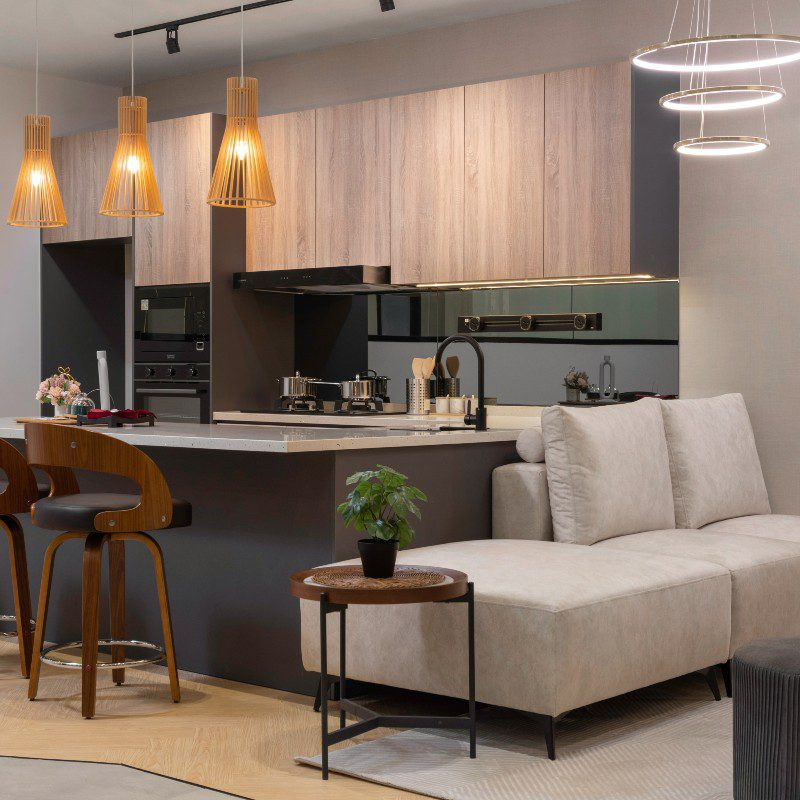
In residential design, an open space refers to a floor plan where two or more traditionally separate areas—such as the kitchen, dining room, and living room—are merged into a larger, uninterrupted zone.
Rather than dividing rooms with walls or doors, this layout utilises visual cues, such as furniture placement, ceiling treatments, or lighting, to define different functions within a single shared environment.
It’s a concept that prioritises openness, movement, and spatial flexibility over rigid room boundaries.
The Comfort and Clarity of Open Space Living

Open layouts have a way of making a home feel calmer, lighter, and more connected. These key benefits show why this design style continues to gain appeal:
a) Better Flow
With fewer walls to navigate, people can move more freely and comfortably between functional areas, improving the everyday experience of the home.
b) More Natural Light
Open layouts allow sunlight to flow freely across the space without obstruction, creating brighter and more inviting interiors.
c) Family and Social Connectivity
It becomes easier to engage with others across different zones—cooking, chatting, and entertaining all happen more fluidly in one shared area.
d) Adaptability
Open spaces can easily be rearranged or repurposed as your needs evolve, making the home feel current and future-proof.
e) A Sense of Spaciousness
Even in homes that aren’t especially large, removing internal walls can make the entire space feel more airy and expansive.
Get inspired by smart solutions for every home—browse semi D house design ideas and uncover small condo interior design tips that maximise both style and space.
Designing Flow: Open Concept Ideas for Every Corner of Your Bungalow
Open-concept layouts are about creating harmony between spaces while allowing each zone to breathe and function with purpose. In a spacious bungalow, where you’re free from tight apartment constraints, this concept becomes even more impactful.
With the right design cues, every corner of your home can feel connected yet distinct. Here’s how to make it work, room by room.
Open Kitchen & Living Space Integration
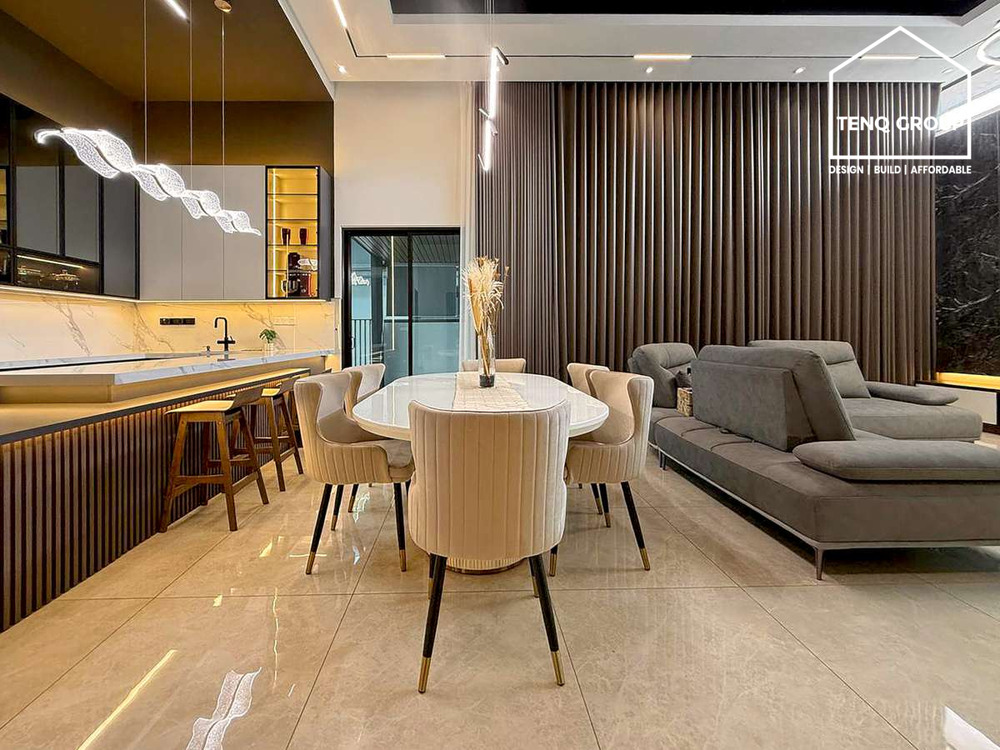
This pairing is the foundation of most open-concept homes. It blends utility with comfort, creating a central hub where daily routines unfold—meals are prepared, conversations spark, and downtime happens without isolation.
- Introduce a kitchen island that gives shape to the space while encouraging easy interaction across zones.
- Extend ceiling treatments, such as wood panels or drop ceilings, across both areas to create visual cohesion without losing distinction.
- Use zoned lighting to control mood and functionality—pendant lights over the island for focus, and soft recessed lights in the living area to invite relaxation.
Dining & Lounge Area
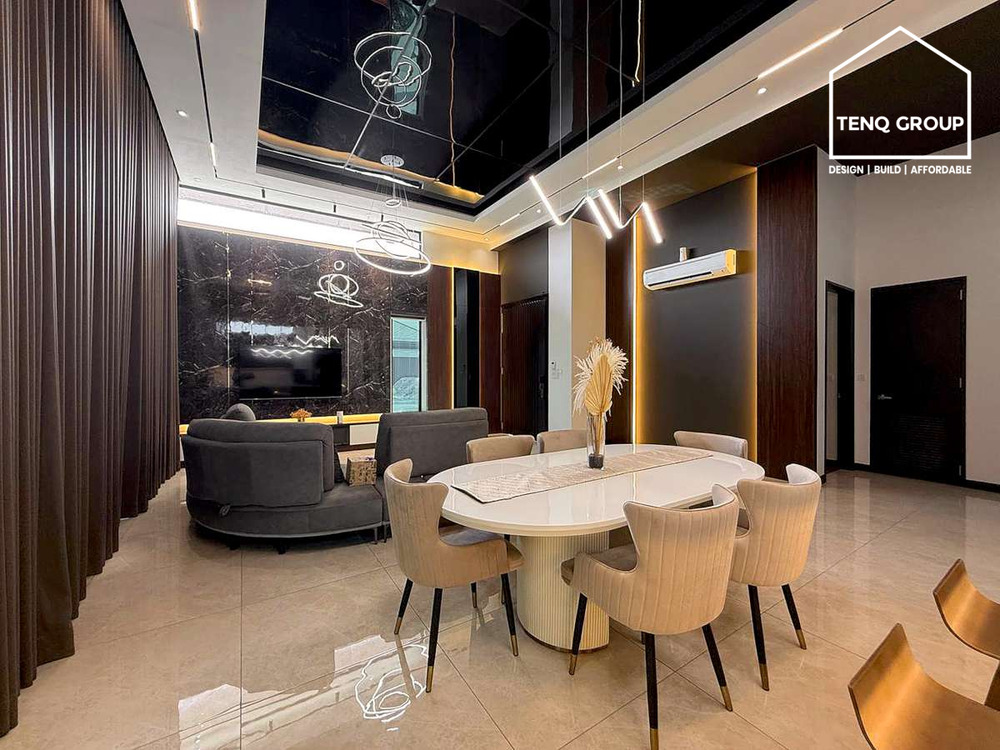
These are spaces for gathering that serve different types of togetherness. The dining area is active and often lively, while the lounge leans into rest and slow moments. The design should reflect that energy shift while maintaining the connectedness of the areas.
- Define the zones using textural contrasts, such as tiles beneath the dining table and warm timber flooring in the lounge.
- Position open shelving or a sleek console between the two areas—this breaks up the space while keeping the visual line unbroken.
- Select furniture with a similar design language but different functions, allowing each space to feel intentional within the larger whole.
Need ideas to complete your open-concept space? TenQ can guide you on incorporating Muji style furniture in Malaysia for a clean, minimalist look that fits seamlessly into every room.
Custom Cabinetry & Hidden Storage

A successful open layout depends on what you don’t see—clutter, cords, and bulky furniture can quickly ruin the flow. Thoughtful storage is what makes minimalism liveable and elegance effortless.
- Incorporate built-in cabinetry that blends seamlessly with the walls to avoid clutter and reduce the need for standalone units.
- Use tall storage features as partial dividers—perfect for subtly separating the dining zone from the kitchen while keeping everything accessible.
- Lean into furniture with built-in storage: coffee tables, benches, and bed frames that hide mess while maintaining a sleek, modern silhouette.
Find out why choosing a custom cabinet in Malaysia is the ideal solution for creating a clean, functional, and seamless look in your bungalow’s open-concept space.
Indoor–Outdoor Transitions
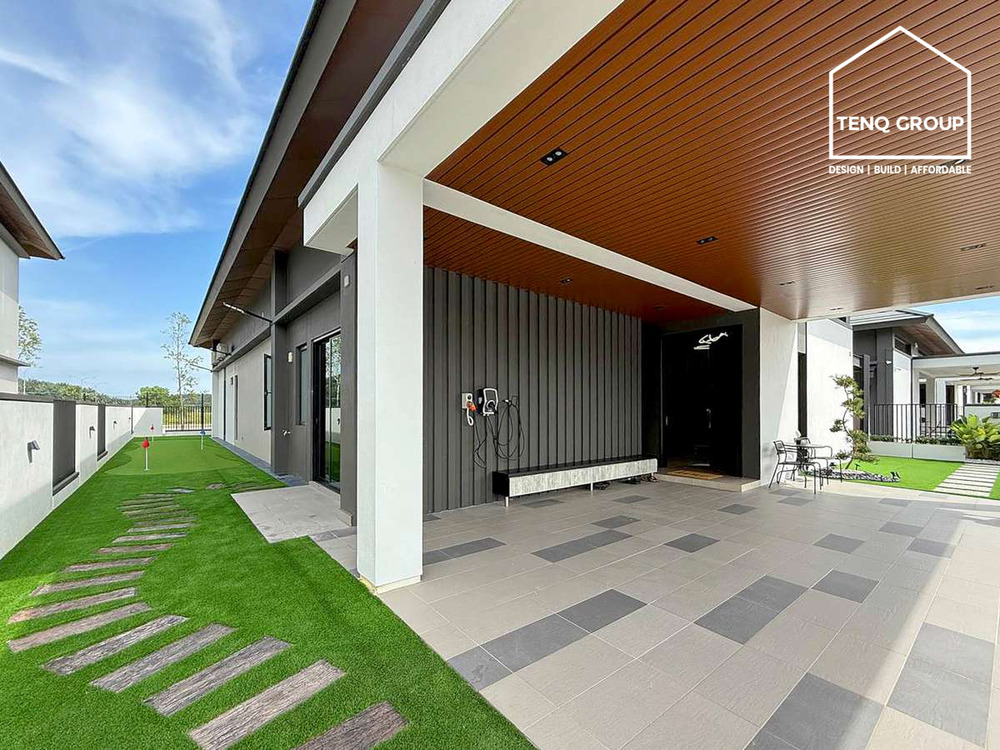
This is where the open-concept idea extends beyond the walls, blurring the line between your living area and the outdoors, creating a seamless transition between nature and comfort. It invites breezes, sunlight, and scenery into your daily life.
- Add sliding or folding glass doors that fully open up the space, allowing the patio or garden to feel like an extension of the living room.
- Mirror indoor finishes outdoors: use similar tones in decking, outdoor tiles, or ceiling treatments to maintain a cohesive visual rhythm.
- Anchor the outdoor zone with familiar elements—a seating area that matches your indoor aesthetic, or a pergola that mimics your ceiling form—to maintain visual continuity across the threshold.
Get inspired by timeless elegance and refined details—explore luxury home interior design ideas that elevate every corner of your space.
The Secret to Open Spaces That Work
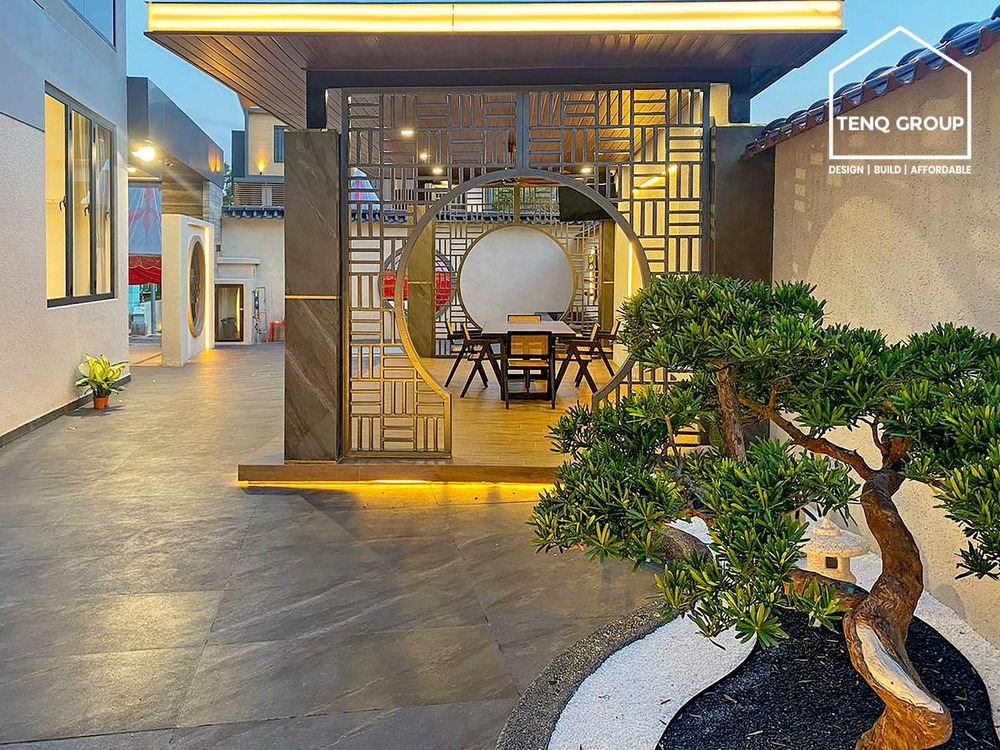
A well-executed open-concept layout with simplicity is achieved through careful planning. In larger homes like bungalows, striking the right balance between openness and functionality is essential.
These key considerations will help ensure your open-concept space feels complete, cohesive, and comfortable to live in.
| Consideration | Details |
| Consistent Colour Palette | Use similar tones across connected spaces to maintain a calm, continuous flow. Stick to colour schemes with subtle variations to avoid abrupt transitions. |
| Material and Texture Harmony | Choose finishes that complement each other—like pairing warm wood with neutral stone. Avoid mixing too many contrasting surfaces that can visually break the space. |
| Zoning Without Walls | Define each space using furniture placement, ceiling levels, flooring materials, or lighting layers instead of walls. This keeps the layout intuitive without blocking flow. |
| Acoustic Planning | Open layouts can carry sound, so use rugs, curtains, upholstered furniture, or acoustic panels to reduce echo and maintain a comfortable noise level throughout the home. |
| Airflow and Ventilation | Ensure cross-ventilation with windows, ceiling fans, and proper kitchen hoods. This keeps the space comfortable and prevents cooking smells from lingering. |
Planning a terrace house renovation? Find out the key considerations to ensure your upgraded space is both stylish and functional from the start.
Transform Your Bungalow with TenQ’s Open-Concept Interior Design Expertise
Looking to elevate your home with a spacious, seamless layout? TenQ brings expert craftsmanship and creative precision to every open-concept project—especially for bungalow owners who value thoughtful design and functional beauty.
Backed by a solid portfolio in interior design in Klang Valley, we help you reimagine space with intention, flow, and balance.
Our team has extensive experience in interior design bungalow in Malaysia projects, delivering more than just aesthetics—we design homes that work for real life.
Here’s how we do it:
a) Purposeful Space Planning
Our layouts prioritise openness while guiding movement naturally between zones. You’ll get a home that feels expansive yet anchored with clear functions.
b) Seamless Storage Solutions
Built-in cabinetry, custom shelving, and multi-functional fittings keep your space looking clean, open, and practical—no bulky distractions in sight.
c) Cohesive Materials and Colour Palettes
We help you select finishes and tones that speak the same visual language, ensuring consistency throughout your bungalow.
d) Defined and Open Lighting Concepts
Our designs use lighting and ceiling features to frame spaces gently—giving every corner its own character without interrupting the flow.
e) Complete Project Management
As a leading Malaysia interior designer, TenQ handles everything in-house—planning, renovation, furnishing, and detailing—so you can relax while your vision takes shape.
If you’re ready to create a home that feels as good as it looks, TenQ is here to make your open-concept dream a reality.
Conclusion
Open concept living brings clarity, comfort, and a sense of connection to everyday life. Bungalows offer generous space and exciting potential for open layouts. When guided by thoughtful design, that openness becomes both inviting and purposeful.
Thinking about opening up your space? Contact TenQ Group for a personalised consultation and discover how an open-concept layout can be tailored to match your lifestyle and design goals.

